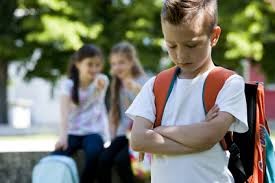It is estimated that 160,000 children miss school every day due to the fear of being attacked by another student. Additionally, 1 in 7 students from kindergarten through twelfth grade is either a bully or a victim of bullying. Whether kids are doing the bullying or being bullied they may experience serious, lasting consequences.
In order to combat bullying, it is essential to be able to identify the behavior. Bullying is aggressive, repetitious, and has an imbalance of power. Bullying can take on a variety of forms including:
- Physically Attacking – Tripping someone or spitting at someone
- Verbal/Emotional Attacking- Calling someone names or telling someone that they are ugly
- Spreading Rumors– Gossiping about others or saying something that is not true about others
- Exclusion – Intentionally leaving someone out or announcing that they are not invited
- Damaging Personal Property – Persistent tugging on a book bag or “grafiting” someone’s notebook
- Encourage children to speak to a trusted adult that can provide comfort, support, and advice.
- Teach children how to stand up to kids who bully. For example, say “stop” with confidence to the bully.
- Discuss strategies for staying safe. For example, walking in groups and staying with friends.
- Encourage children to help other friends and classmates who are being bullied by showing kindness and getting an adult to help.
Research suggests that children look up to parents and trusted adults for advice on tough decisions. In addition, research suggests that spending 15 minutes talking to children can reassure children that they can come to you with the problems that they have. Get the conversation started by using simple, direct questions about your child’s day. For example, What did he or she do during the day? How was his or her lunchtime? What did he or she do during recess?
Encourage the children in your life to participate in activities, interests, and hobbies that they like. Allow children to express their interests and give them the opportunity to have fun and meet others who share the same interests. Through activities, children build confidence and friendship that can be protective from bullying.
Model how to treat others with kindness and respect. By doing so, children learn that their world is not a place for bullying. Even though sometimes it feels that children are not watching they are constantly picking up cues on how the adults in their lives are dealing with stress and conflict, as well as how adults are treat others.
Bullying can best be prevented using a community approach. Using a community-wide strategy parents, schools, youth organizations, and stakeholders support children who are bullied and redirect bullying behavior. Encourage your community to take a Zero-Tolerance stand on bullying by being aware of your local polices and prevention programming.
Written By:
Jenifer Bennett, Human Development and Family Sciences Intern
Carmen Irving, Healthy Relationships Program Specialist Family and Consumer Sciences, Ohio State University Extension, irving.31@osu.edu
Reviewed By:
Michelle Treber, Family and Consumer Sciences Educator, Ohio State University Extension, Pickaway County, Heart of Ohio EERA, treber.1@osu.edu
Resources:
http://www.nea.org/home/53359.htm
http://www.stopbullying.gov/index.html
http://www.dosomething.org/tipsandtools/11-facts-about-cyber-bullying



